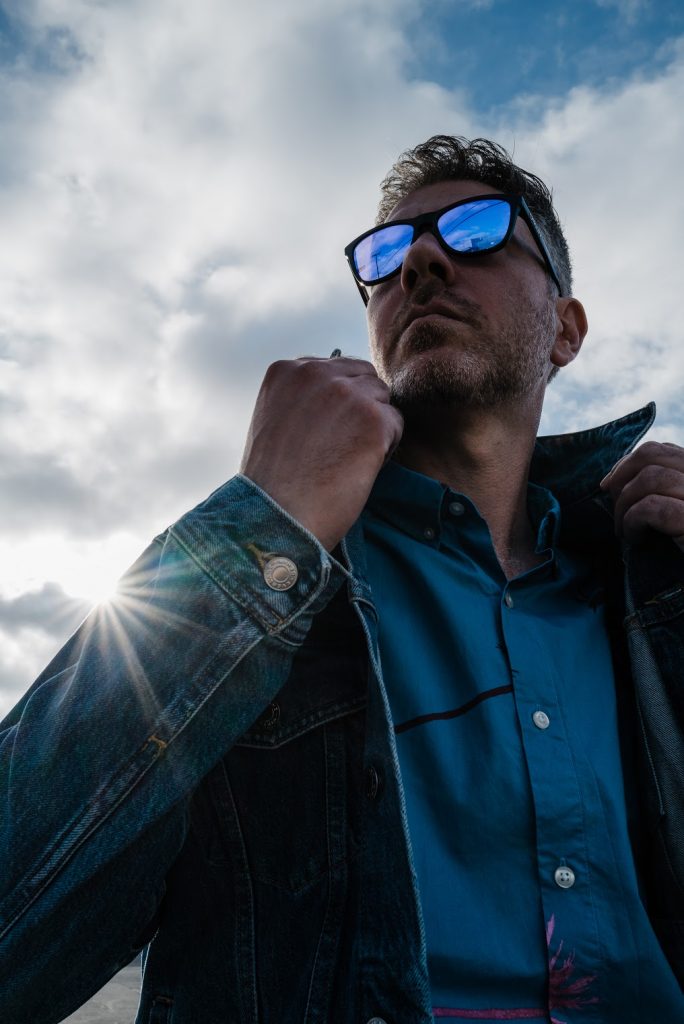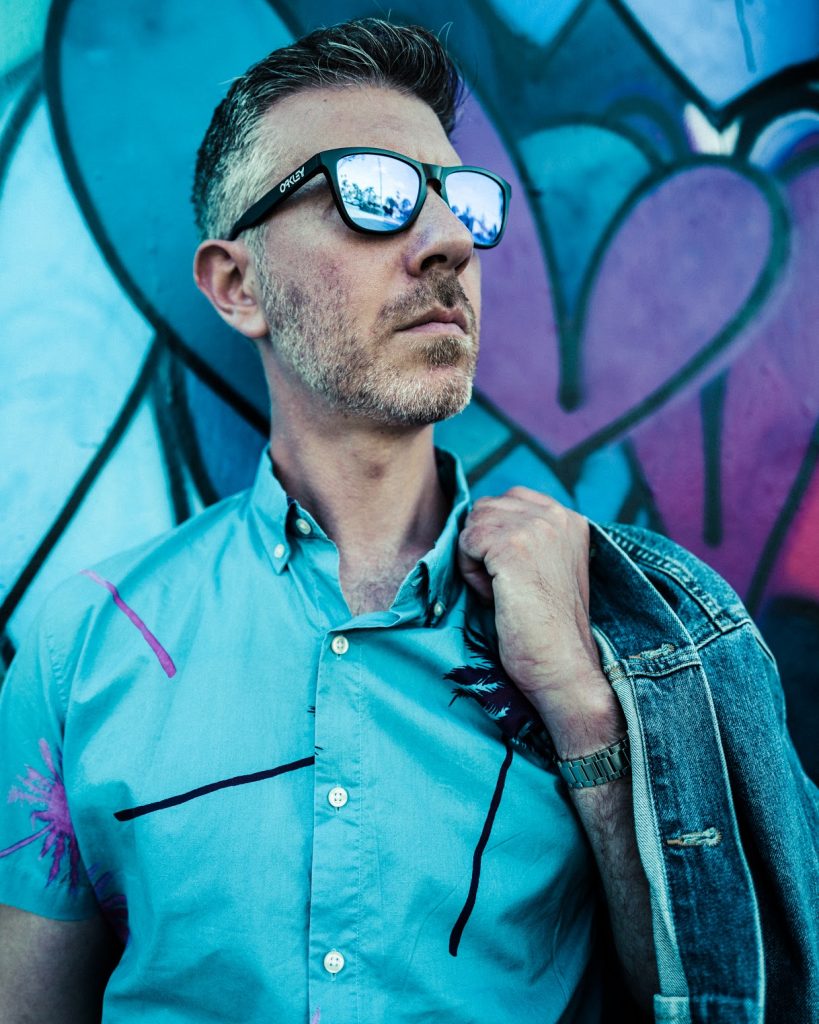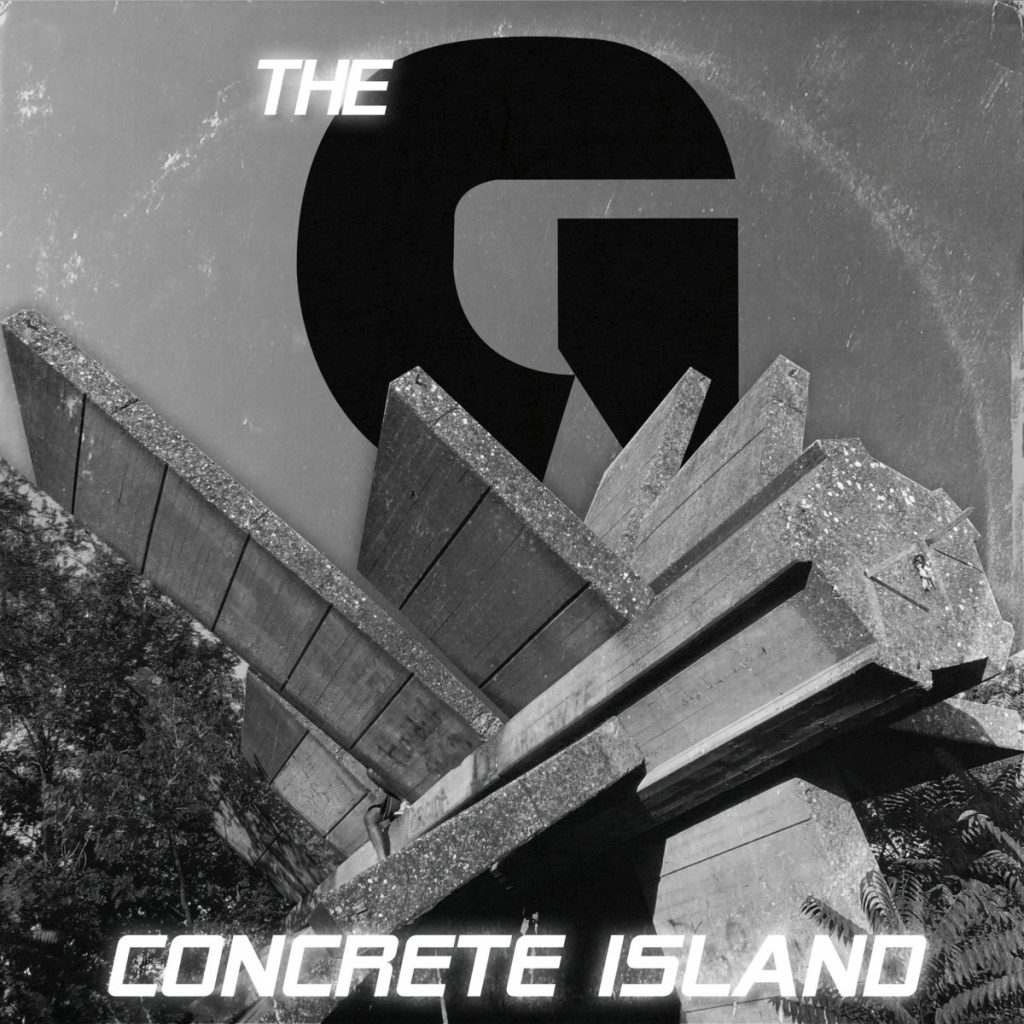Filled with blistering retro synthwave bliss, “Wanderers” is the latest smash-hit album from The G! It’s hard to understate just how nostalgic this record sounds, as it’s filled with OG (pun intended) synth sounds that immediately take you back to when the genre was young and fresh. It’s also chock-full of features from wonderous artists like JJ Mist, Vampire Step-Dad, Vandal Moon, Michelle B, and Dimi Kaye!
Although he’s been producing music since at least 2015, “Wanderers” is The G’s first release with NewRetroWave (his previous fantastic releases “Cosmopolis” and “Concrete Island” being released on TimeSlave Recordings.) To celebrate this astounding album, we reached out to The G for an interview to get a peek behind the scenes at his equipment, production style, and how he makes the magic happen!
The G’s Background and Production Style

Thanks for doing the interview! Can you tell us a bit about your background?
I’ve been making synthesizer music since I was 12. My parents got me a Roland D-50 from one of those guys who’s always selling stuff out of the garage – unopened and still in the box! Who knows where it came from.
Anyway, I had no idea how to program it so I just did stuff until it sounded cool. Then I got more into guitar and started playing in bands. Later, in college, I discovered techno and house music and decided I wanted to do that. So I took a bunch of studio engineering classes and taught myself how to spin records. I started DJing at local clubs in Michigan and producing a bit. So I’ve been working on stuff since then.
A couple years ago I went back to some of those old tunes and realized they are basically me trying to make synthwave before I knew what that was. It’s all ‘80s synth sounds and LinnDrum samples. It’s just that I was trying to shoehorn it into a techno framework back then.
“When I first listened to those, I knew I’d found what I was looking for.”
What initially drew you into Synthwave and its subgenres?
I was working on a thing called Cyberpunk Revisited for a science fiction blog. It was a retrospective on the cyberpunk literature of the 1980s, as well as related media. I wanted to find music that could go along with writing. I’ve always loved Cybotron, and eventually, I found a Spotify playlist that had the whole album “Enter“ on it. It’s basically cyberpunk itself – “Enter” came out at almost the exact same time as “Neuromancer.”
Anyway, the playlist also featured “88:88“ by Makeup & Vanity Set and “Skull and Shark” by Lazerhawk. When I first listened to those, I knew I’d found what I was looking for. Not just music to write to – this was the sound I had always been looking for. I went down the similar artists’ rabbit hole and discovered all the other big names of that era. Then the smaller ones. After a few months, I was spending more or less every night trying to make some of my own.
What is your go-to production gear?
I use a combination of hardware and software. Basically, hardware is more fun but software is more convenient. On the hardware side, right now I have a Roland Ju-06, Sequential OB-6 and ASM Hydrasynth, but when I did “Wanderers” I was also using a Roland JX-3P. It’s all over the record – that opening arpeggio in “Wanderers” and the chords in “Can’t Wait,” for example. I’ve got a few guitars and a bunch of pedals. I’m obsessed with pedals.
All that said, I do use a lot of software. Logic is my main DAW, though I sometimes produce in Reason too. I love U-He’s plugin synths, like Diva and Repro. They sound so big and full, though also a bit too clean – but you can always dirty things up with effects. I really like TAL’s U-No-Lx, which is a Roland Juno emulation, and I’m a big fan of OP-X Pro II by Sonic Projects. OP-X doesn’t sound exactly like the Oberheim synths it’s trying to emulate, but it does a great job capturing oscillator drift and the “warming” effects of age that you get with vintage analog hardware. For creative effects and sound processing, I use a lot of stuff by Soundtoys, FabFilter, UAD, Softube, Brainworx and BABY Audio. A bit of Waves too, but I find their plugins are really hit or miss.
“A lot of pros will tell you that’s ass-backwards…”
How do you go about creating music – what’s your process?
So I usually start with an arpeggio or chord progression – something I get in my head. I throw a kick drum underneath it, then a snare. Then I start messing around with bass progressions to see what hooks. I usually build that up to a loop, then decide if I want parts (like a pop song) or shifts in pattern (like a dance track). I do both. The arrangement I choose is determined more by the vibe than anything else. Whatever works, basically.
I’m a tinkerer – so I’m working on the mix as I go along. A lot of pros will tell you that’s ass-backwards, that you should put the track down and then mix as a separate process. But I’m an audio engineer at heart, so I can’t help myself. It’s just fun to me. And I can’t focus if the mix sounds off.
How “Wanderers” Came To Be
“Wanderers” takes synthwave back to its roots. What made you want to go in that direction now, when so many others are branching out and incorporating new genres into synthwave?
I’ve always loved synthwave in its purest form. “Deja Vu” by FM Attack, “Plug and Play” by Betamaxx or basically anything from Timecop1983. The synths are so lush and shimmery, the music so evocative – it’s like you’re being transported to another place and time. A place and time that may never have really existed, but it’s also capturing something genuine. Steve OSC recently said on Twitter that synthwave isn’t reflective of the actual ‘80s, but the ‘80s how people remember it. That rings true for me, and I think it fits “Wanderers” pretty well. The ‘80s were really the last time when people dreamed big about the future. And in the end, that’s what the album is about. Staring up at the stars and dreaming about the future, and the futures lost.
At the same time, I am bringing in some external influences that aren’t that common in synthwave. A few of the songs – like “Away” or “Spiral” – incorporate sounds, textures and techniques from Dreampop, which is another one of my favorite genres. “Gardens of the Moon” and “Remember” have elements of post-punk, specifically The Chameleons. About half the songs feature guitar – and acoustic drums aren’t something you hear much in synthwave. So in that sense I am trying to do something different. But I’m not saying you’re wrong – for me at least, “Wanderers” sort of is and isn’t purist synthwave at the same time. Like Schroedinger’s cat I guess!
“I’ve always loved synthwave in its purest form.”
Your last album, “Concrete Island” had a much darker, more late 70s early 80s vibe with nods to Vangelis – why the change in tone now?
I get a lot of ideas, but only some of them gel. For “Concrete Island” I had something really specific in mind – I wanted to score the soundtrack to an imagined film, a post-apocalyptic art film set in 2017 but made in 1983. The kind of thing David Cronenberg would have directed. Black and white, slow-moving and atmospheric as hell.
As much as possible, I tried to only use sounds and effects that were available at that time. Old Oberheim, Roland, and Sequential Circuits synths, mainly. Analog delays and plate reverbs for the effects. Most of the drums were generated on a Roland Jupiter-8 and a Prophet 5, then sampled.
“Wanderers” emerged more organically. I had a couple of pop songs and a couple of harder, darker tunes. They didn’t have the same energy or vibe, but I was making them with the same sounds – so they did kind of make sense together. And then it occurred to me: most synthwave albums give you ten songs with one vibe. Chill, dark, dreamy or whatever. And there’s nothing wrong with that approach – Concrete Island is like that too, after all. But when you go back to classic albums of the ‘80s, that’s almost never the case. You get upbeat songs after downtempo songs, or angry songs that fade out into ballads – all in 45 minutes. The best albums of that era take you on an emotional journey, the kind of journey most people go through in life. I wanted to make something that had an emotional range. Something that takes you on a journey.
Did any of your gear or process change when creating “Wanderers?”
Definitely. I started the album way back in 2017, and was originally planning to release it in 2018 – before “Concrete Island.” But what I had at that point was fairly primitive compared to “Wanderers.” So I’m definitely glad I took my time.
There was also a big delay in the middle, which sort of reset the production process for me. Basically, in mid-2018 I moved back to LA from Singapore. There was a lot going on and I had to sell a bunch of gear too. Stuff that just wasn’t going to make it in a cargo container across the Pacific. Plus I had access to some vintage synths when I was in Singapore, which I didn’t have anymore after the move. So I spent a lot of time sampling into Logic. Then, after I arrived in LA, I got some new gear – like the OB-6 and Hydrasynth. I wanted to really learn them well, and that took time too.
Process-wise, well, I’d done one vocal track before, “Stars that Fade,” which is a collaboration with Vandal Moon. “Wanderers” has five vocal tracks – two with Michelle B, one with JJ Mist, another one with Vandal Moon and then one where I’m singing myself. Producing and mixing vocals is one of the hardest things to do well. At least, it is for me.
And the album features a lot of elements I’ve never done before on a synthwave record. The drums are a mix of electronic and acoustic, there’s a ton of guitar and I consciously borrowed some effects techniques from shoegaze, which you can hear most clearly on “Away” and “Spiral.”
The Future

People are saying “Synthwave is Dead” nowadays – and yet here you are creating really fantastic tunes that remind me of the early days of the genre. Where do you think the genre as a whole is headed?
Appreciate that! I have a lot of love for the genre’s early history, so I definitely take that as a compliment.
To answer your question, I don’t think synthwave is dead, dying, fading, or anything at all like that. It’s thriving, actually. Off the top of my head, I can think of 30+ synthwave artists making fantastic music right now. It’s just that the scene has been around for a while now – so the thrill of newness has faded, and you’ve also got an avalanche of releases. As a listener and fan, that can get fatiguing.
I think a few things have been going on the last few years, all of which are related to that. First, the idea of synthwave has been growing more diffuse. There are more things synthwave can be and still be considered synthwave. A lot of the best records these days are mixing in stuff from outside the genre, but it’s still recognizable as synthwave.
Second, the scene has started coalescing around labels that do physical releases. It’s hard to get noticed if you aren’t on one of those platforms. It’s not impossible, just harder. And you probably have to pay for professional services. Meanwhile, traditional netlabels are dying. Collectors want something tactile: vinyl, cassettes – even minidiscs are back.
“I don’t think synthwave is dead, dying, fading, or anything at all like that. It’s thriving, actually.”
The most successful labels right now all do physical releases. NRW, Fixt Neon, Timeslave Recordings, Electric Dream Records, Electronic Purification Records. There are probably more but those are the ones I can think of off the top of my head. You also have the big independent acts like The Midnight, Gunship and FM-84, but I think it would be harder to embark on that path in 2021 than it was in 2015. At a high level, I expect both of these processes to continue. I also expect that we’ll start to see more nostalgia for first wave synthwave. Kavinsky, College, the Valerie Collective, early Miami Nights 1984 or FM Attack. We’ll probably start seeing acts that are specifically trying to sound like that.
Besides your previous releases Cosmopolis and Concrete Island, what other synthwave related projects have you worked on?
I’ve also got an EP out on Timeslave Recordings called The Pacific Coast. It’s palm trees and pool party music that I made in 2016. Sounds fairly primitive when I listen to it now, but simplicity can be fun too. Looking beyond synthwave, I’ve got a shoegaze project that I’m working on. I’m very excited about where it’s at right now, but we won’t launch it until 2022.
Follow The G:






